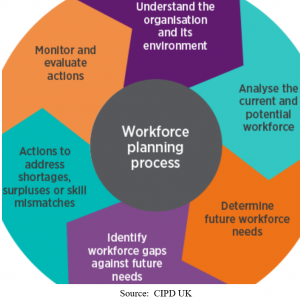“In many organisations, the habitual approach to workforce planning is just a short-term budget and headcount exercise. Attempting to be this granular and precise is not useful when looking longer term, especially when the environment is uncertain.”
Julia Howes – Principal, Mercer
Why is it important for HR heads to have a long-term strategy on workforce planning and skills development?
The answer seems obvious. When a country faces unemployability rates of 60-65% and around 12 million youth looking to enter the workforce annually, proven human capacity building approaches such as apprenticeships become pivotal for employers to have the ability to mold youth with the skills they require for the future. Burying our heads in the sand and waiting for the crisis to pass risks everything our businesses stand for.
What Is Workforce Planning?
It can be defined as a fundamental business process of matching evolving organisation needs with people strategy. Workforce planning indisputably gets a top spot for the most crucial activities for organisations, especially HR leadership, to be engaged in. People make up organisations, ergo the right person for the job at the right time and at the right wage level are possible only if timely HR strategies are in place. Anticipation, planning and actioning steps to meet workforce requirements in support of long-term business goals thus becomes a core function of any forward-thinking business.
Apprenticeships in Workforce Planning
What are the key challenges from a skills scenario? We know that HR decision-makers often have to grapple with finding the right people. Workforce planning involving wrap-around ‘learning by doing’ models such as apprenticeships can help organisations take charge and be ready to labour market and business changes, rather than resorting to knee-jerk reactions. Workforce forethought involving apprenticeships help:
- Identify and fill skill gaps
- Lower recruitment and attrition costs by training ‘one’s own’
- Enhance internal workforce skills
- Build a future talent pool
- Respond to technological and automation changes
- Drive higher output and productivity
A Mindset Change
Indian employers need to give apprenticeships a serious chance. There’s plenty of data and evidence that we have written about proving apprenticeships work. So what is stopping our employers from embracing apprenticeships as a key strategy for workforce development? Fear of the unknown and perceptions of the process being complicated perhaps. At best we have 3.5-4 lakh apprentices representing a minuscule .1% of the workforce. India Inc with its 71 million enterprises, why do only 50,000 of them engage with apprenticeships? While HR practitioners may in principle acknowledge the importance of workforce planning, and apprenticeships, in particular, there exists a ‘knowing–doing’ gap preventing them from taking the much-needed steps to strengthen their talent pool. Workforce planning is an iterative process involving recruitment, training, and deployment of people needed to get the job done. But if managers wait until the eleventh hour, where will the right people with the right skills needed to do the job come from?
“A lot of issues of the skills space get resolved if apprenticeships take off. Most countries who have done well on VET, like Germany and Switzerland, it has been the dual learning mode where 80% of the training route is via apprenticeships. If they have done it right, why can’t we too?”
Rajesh Aggarwal, Joint Secretary Ministry of Skill Development and Entrepreneurship, on apprenticeships as a blueprint for success (at a NETAP-IAF event)
What Can Be Done
An operational initiative for people planning aligned with business goals can involve the following steps:


If apprenticeships become integral to this prudent approach, employers can build agility in their workforce by honing the exact skills needed for their business. In parallel, youth improve their social mobility with increased chances of becoming part of an organised workforce respectful of worker rights. This holds special significance for a country like ours where close to 90% of the workforce is classified as informal. No wonder then that governments the world over have used apprenticeships as a policy solution to convince industry cohorts to espouse apprenticeships as a powerful means to ease challenges of unemployment and underemployment.
A National Call-Out
Touting apprenticeships as the very key to unlock skill development in the country, members of the Economic Times India Leadership Council (ET ILC) have taken on a novel initiative to bring India Inc. closer to apprenticeships. Through its singular national programme ‘Livelihood Enrichment Through Skill Development’, the Core Group on Skilling of the ET ILC have pulled its industry members to the drawing board along with government representatives from the MSDE and NSDC. Senior leadership from the ILC’s members have pledged to make the National Apprenticeship Promotion Scheme (NAPS) a national priority and become brand ambassadors for the same after having successfully implemented the NAPS within their individual corporate houses.
It is heartening to see key stakeholders sitting up and noticing the value of apprenticeships to nurture and develop the skills of our workforce. Success will be determined by how well apprenticeships have been embedded in a continuous workforce planning approach to bring new talent into organisations in line with business needs.














